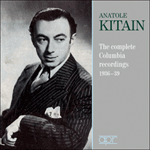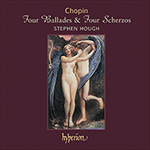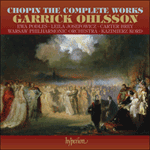The Second Ballade is dedicated to Schumann and its violently opposed first and second subjects could hardly have been excelled by that master of vivid contrasts. The opening quaver crotchet rhythm establishes the basic compound duple time, but the music’s deceptively placid progress is enlivened by syncopation and several surprise turns, a remarkable instance of simplicity without monotony. The subsequent tornado (sufficiently sudden to encourage all lovers of programme music) subsides, and a series of left-hand scales gradually calms the fury of this wintry blast. The principal subject returns and after a brooding development and a passage of great improvisatory daring the second subject’s violence is once more unleashed. Insistent tremolandi and trills announce a coda whose percussive force looks ahead towards the twentieth century and to the caustic brilliance of Prokofiev. Chopin, however, reserves his masterstroke for the final bars where the opening theme reappears plaintif and resigned in A minor, its original and, in retrospect, naive optimism defeated.
from notes by Bryce Morrison © 2004
La Seconde Ballade dévoile une opposition violente des premier et second thèmes que Schumann, ce grand maître des contrastes vivides et dédicataire de l’œuvre, n’aurait guère pu surpasser. Le rythme initial de croche-noire établit le temps de base de la mesure binaire composée. Pourtant le progrès trompeusement placide de la musique est animé par des syncopes et plusieurs tournures surprenantes, un exemple remarquable de simplicité dénuée de monotonie. La tornade qui suit (suffisamment soudaine pour encourager tous les adeptes de musique à programme) s’évanouit, et une série de gammes à la main gauche calme progressivement la furie de cette bourrasque hivernale. Le thème principal revient. Après un large développement et un passage d’une grande audace improvisée, la violence du second thème se déchaîne de nouveau. Des tremolandi et des trilles insistants annoncent une coda dont la force percussive laisse préfigurer le XXe siècle et le brio caustique de Prokofiev. Chopin, pourtant, réserve son coup de maître pour les dernières mesures où le thème initial réapparaît en la mineur, plaintif et résigné, son optimisme originel et rétrospectivement naïf vaincu.
extrait des notes rédigées par Bryce Morrison © 2004
Français: Isabelle Battioni
Die Zweite Ballade ist Schumann gewidmet und die absolut unterschiedlichen beiden Hauptthemen hätten von dem Meister der starken Gegensätze kaum besser geschaffen werden können. Der Achtel-Viertel-Rhythmus am Anfang etabliert den Zweiertakt, jedoch wird der trügerisch beschauliche Fortschritt der Musik durch Synkopierungen und mehrere überraschende Wendungen aufgerüttelt: ein bemerkenswertes Beispiel für Schlichtheit ohne jede Monotonie. Der darauffolgende Sturm (der plötzlich genug kommt, um alle Liebhaber der Programmmusik anzusprechen) legt sich, und eine Reihe von Tonleitern in der linken Hand sorgt dafür, dass allmählich wieder Ruhe einkehrt. Das Hauptthema erscheint wieder und nach einer grüblerischen Durchführung und einer Passage von ungeheurer improvisatorischer Kühnheit wird die Heftigkeit des zweiten Themas noch einmal freigesetzt. Eindringliche Tremolandi und Triller kündigen eine Coda an, deren perkussive Kraft das 20. Jahrhundert und die beißende Brillanz Prokofievs vorwegnimmt. Chopin behält jedoch seinen Glanzstück bis zum Ende zurück, wenn das Anfangsthema Plaintif und in einem resignierten a-Moll zurückkehrt und der ursprüngliche – und rückblickend naive – Optimismus geschlagen ist.
aus dem Begleittext von Bryce Morrison © 2004
Deutsch: Viola Scheffel


 Anatole Kitain - The complete Columbia recordings, 1936-39
Anatole Kitain - The complete Columbia recordings, 1936-39 Chopin: Four Ballades & Four Scherzos
Chopin: Four Ballades & Four Scherzos Chopin: The Complete Works
Chopin: The Complete Works
